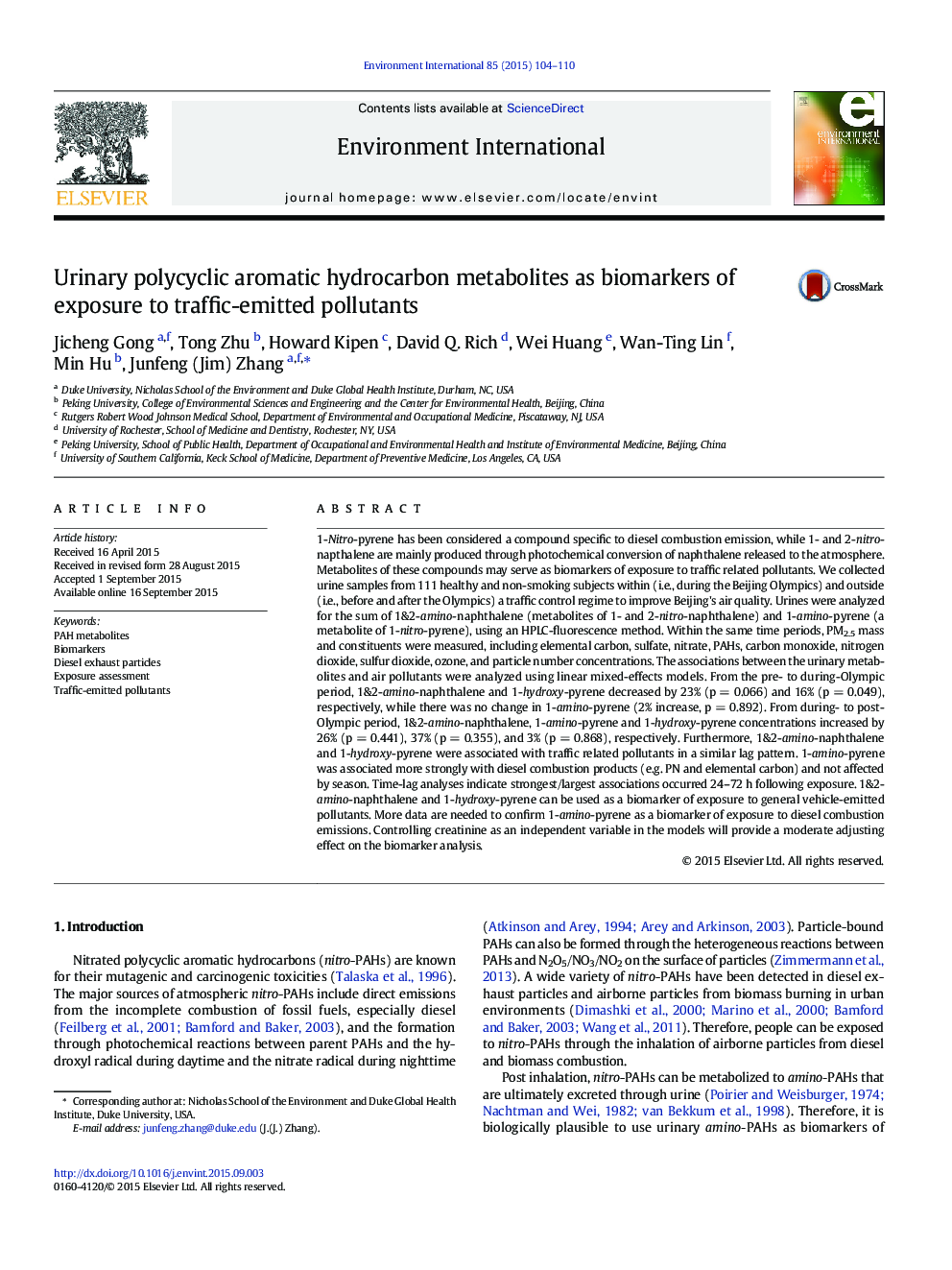| کد مقاله | کد نشریه | سال انتشار | مقاله انگلیسی | نسخه تمام متن |
|---|---|---|---|---|
| 6313561 | 1619043 | 2015 | 7 صفحه PDF | دانلود رایگان |
عنوان انگلیسی مقاله ISI
Urinary polycyclic aromatic hydrocarbon metabolites as biomarkers of exposure to traffic-emitted pollutants
ترجمه فارسی عنوان
متابولیت های هیدروکربن آروماتیک پلی سیکل ادرار به عنوان نشانگرهای زیست محیطی در معرض آلودگی های ناشی از ترافیک
دانلود مقاله + سفارش ترجمه
دانلود مقاله ISI انگلیسی
رایگان برای ایرانیان
کلمات کلیدی
موضوعات مرتبط
علوم زیستی و بیوفناوری
علوم محیط زیست
شیمی زیست محیطی
چکیده انگلیسی
1-Nitro-pyrene has been considered a compound specific to diesel combustion emission, while 1- and 2-nitro-napthalene are mainly produced through photochemical conversion of naphthalene released to the atmosphere. Metabolites of these compounds may serve as biomarkers of exposure to traffic related pollutants. We collected urine samples from 111 healthy and non-smoking subjects within (i.e., during the Beijing Olympics) and outside (i.e., before and after the Olympics) a traffic control regime to improve Beijing's air quality. Urines were analyzed for the sum of 1&2-amino-naphthalene (metabolites of 1- and 2-nitro-naphthalene) and 1-amino-pyrene (a metabolite of 1-nitro-pyrene), using an HPLC-fluorescence method. Within the same time periods, PM2.5 mass and constituents were measured, including elemental carbon, sulfate, nitrate, PAHs, carbon monoxide, nitrogen dioxide, sulfur dioxide, ozone, and particle number concentrations. The associations between the urinary metabolites and air pollutants were analyzed using linear mixed-effects models. From the pre- to during-Olympic period, 1&2-amino-naphthalene and 1-hydroxy-pyrene decreased by 23% (p = 0.066) and 16% (p = 0.049), respectively, while there was no change in 1-amino-pyrene (2% increase, p = 0.892). From during- to post-Olympic period, 1&2-amino-naphthalene, 1-amino-pyrene and 1-hydroxy-pyrene concentrations increased by 26% (p = 0.441), 37% (p = 0.355), and 3% (p = 0.868), respectively. Furthermore, 1&2-amino-naphthalene and 1-hydroxy-pyrene were associated with traffic related pollutants in a similar lag pattern. 1-amino-pyrene was associated more strongly with diesel combustion products (e.g. PN and elemental carbon) and not affected by season. Time-lag analyses indicate strongest/largest associations occurred 24-72 h following exposure. 1&2-amino-naphthalene and 1-hydroxy-pyrene can be used as a biomarker of exposure to general vehicle-emitted pollutants. More data are needed to confirm 1-amino-pyrene as a biomarker of exposure to diesel combustion emissions. Controlling creatinine as an independent variable in the models will provide a moderate adjusting effect on the biomarker analysis.
ناشر
Database: Elsevier - ScienceDirect (ساینس دایرکت)
Journal: Environment International - Volume 85, December 2015, Pages 104-110
Journal: Environment International - Volume 85, December 2015, Pages 104-110
نویسندگان
Jicheng Gong, Tong Zhu, Howard Kipen, David Q. Rich, Wei Huang, Wan-Ting Lin, Min Hu, Junfeng (Jim) Zhang,
